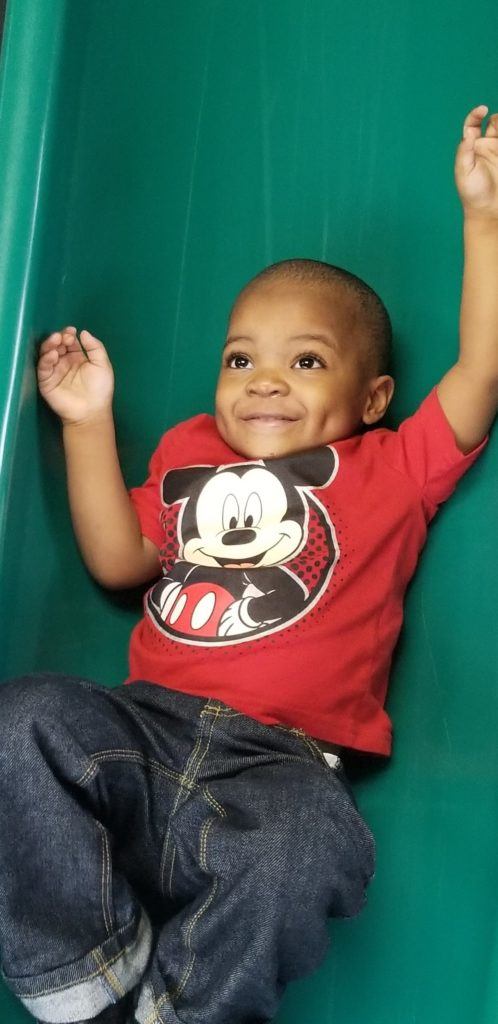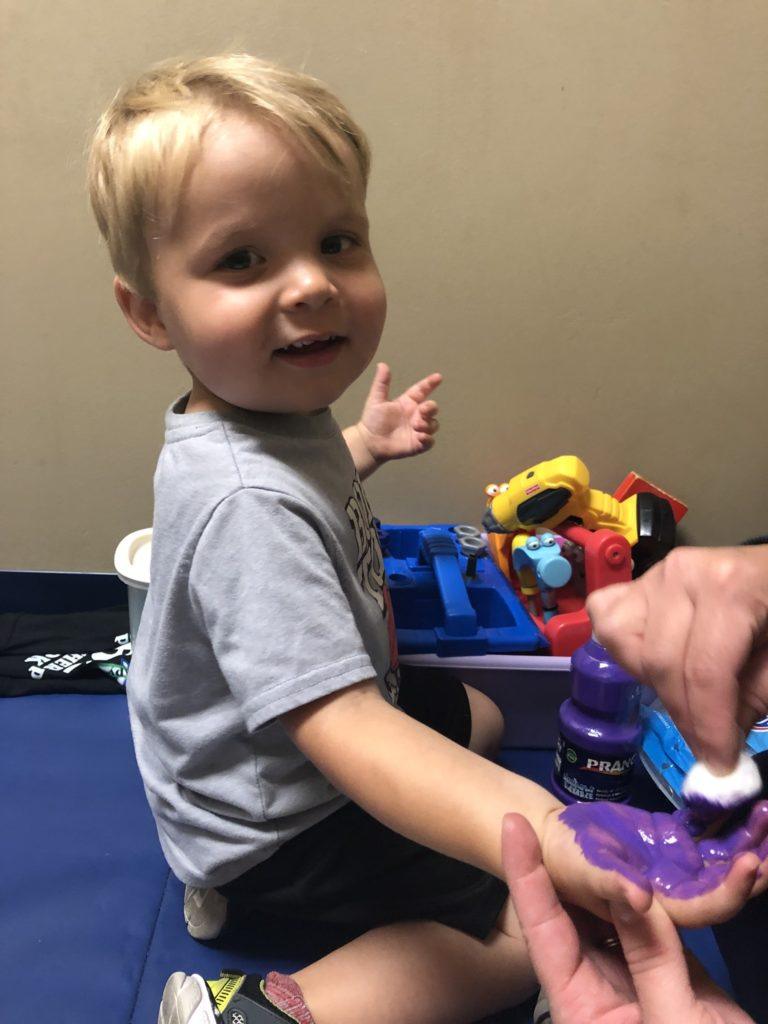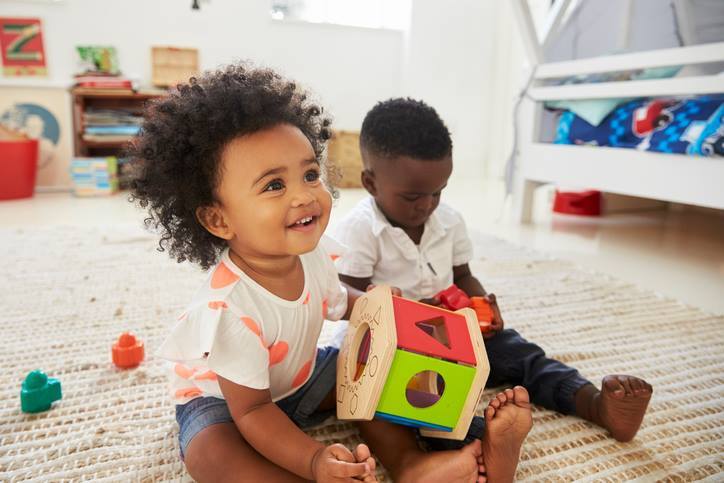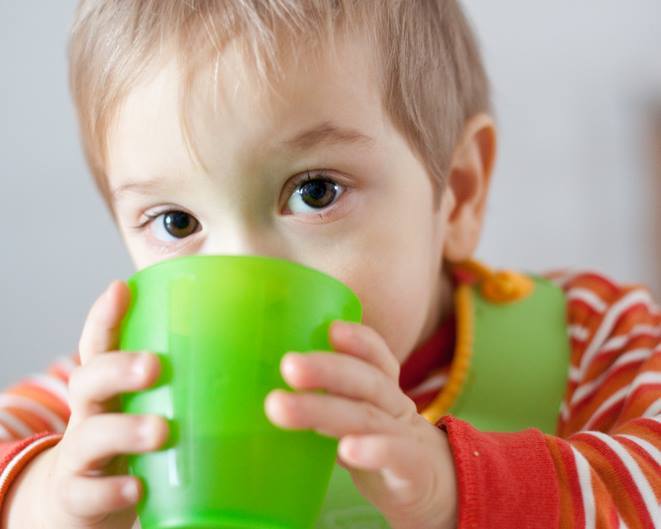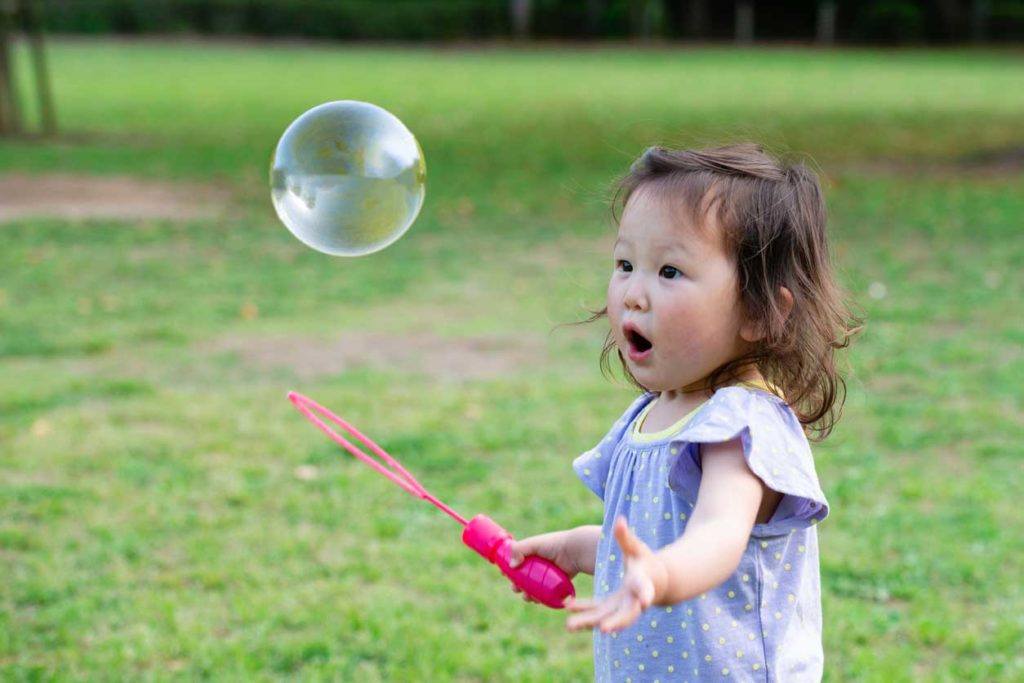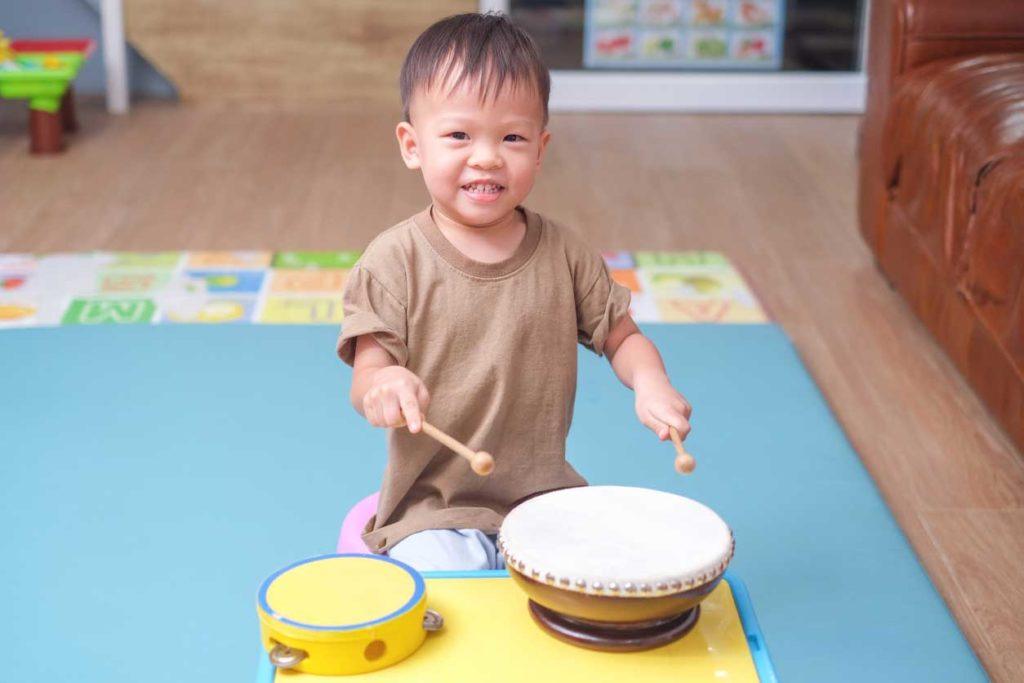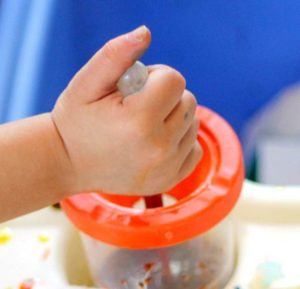Your Child’s Second Year
Development during your child's toddler years are critical for future success. And while every child learns movements at an individual rate, developmental delays may cause concern and hardship. Use our guide below to see what milestones your child should be reaching at every age during the second year. Milestones listed at each stage carry on through each subsequent phase of development (i.e. skills at 12 months should be present at 13 months).
Toddler Milestones – 12 Months
- Transitions to stand using hands and feet (bear stance)
- Walks 8 feet with one hand held
- Walks 5 steps independently
- Corrals a ball in sitting
Helpful Hint: You can decrease or increase the level of support you give your child by changing the position to which you hold their hand. For example, holding their hand overhead is more supportive to your child than one handheld assist at their side.
- Uses a fine pincer grasp
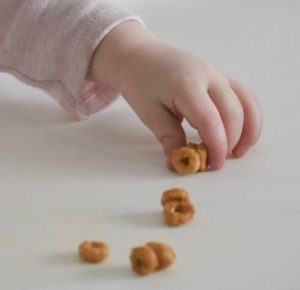
- Needs help for brushing teeth
- Pushes arms and legs through clothes to help dress
- Turns thick pages
- Helps undress
- Pulls off shoes
- Uses a fisted grasp to hold a crayon or marker
- Plays alone or alongside others, but not together
- Understands “no”
- Recognizes own name
- Explores by playing with food
- Begins self-feeding
- Moves food from side to side of mouth
- Begins using a straw
- Will turn when name is called
- Pay attention to simple commands (ex. “no”), but will not always obey
- Imitate actions shown (ex. “waving”)
- Cry upon separation from parents
- Display happiness to see parents, toys, face in mirror
- Understand that the object is still present even if it can’t be seen
- Imitates actions and gestures
- Enjoys looking at picture books
- Displays fear in new situations
- Shows love and affection
- Activity tables to promote standing and cruising
- Bubbles
- Board books
- Toys with surprise element (ex. pop-up)
- Cause and Effect toys
- Balls – large and small
Toddler Milestones – 13 Months
- Maintains kneeling on both knees without bottom touching feet for 5 seconds
- Stoops to retrieve object from the floor without using a stable surface and takes three steps
- Rolls a ball 3 feet forward in sitting
- Flings a small ball while standing
Helpful Hint: Make sure your child’s legs are close together in tall kneel and their bottom is not touching their feet. The wider their hips splay, the more likely they are to assume the “w” position when sitting back. Try to avoid “w” sitting as much as possible.
- Turns pages of regular book when page is lifted
- Imitates scribbling with crayon
- Pushes a toy car
- Brings a filled spoon/fork to mouth
- Plays alone or alongside others, but not together
- Imitates gestures that are new to him or her
- Continues learning to use straw
- May lose some food and saliva when chewing
- Eats some mashed foods
- Learns to ask for help
- Using body language and limited vocabulary to communicate with others
- Sharing is difficult
- Small balls or balled up socks that are easy to grab and soft to throw
- Giant crayons or egg crayons
- Picture books with real photos versus cartoons
Toddler Milestones – 14 Months
- Creeps upstairs on hands and knees
- Walks 10 feet with good balance and heel-toe pattern
Helpful Hint: Watch to see if your child is always leading with one leg when going up the stairs. Try to encourage the use of both legs leading.
- Makes a stack of 2 blocks
- Points at objects with index finger, keeping other fingers toward palm
- Rolls a ball to you
- Plays alone or alongside others
- Hands things to others
- Indicates desired objects through pointing
- Continues trying new mashed foods
- Might attempt to eat soft meats
- Prefers people who are familiar, strangers may cause anxiety
- Can entertain self for few minutes at a time
- Can exhibit a wider range of emotions (love, frustration, jealousy)
- Textured sensory balls
- Books
Toddler Milestones – 15 Months
- Creeps downstairs independently
- Walks upstairs with both rails - non alternating
- Lifts foot to contact ball
- Throws ball overhand without losing balance
Helpful Hint: To encourage stair skills, practice with taking an object up the stairs and doing something fun with it once at the top. For example, carrying a small ball up the stairs and watching it roll down from the top.
- Marks on paper with crayon or pencil without help
- Puts things in and out of containers
- Turns a bottle of small objects over
- Places round object in round opening
- Removes socks with some help
- Plays alone or alongside others
- Identifies one body part
- Waves goodbye
- Uses “mama” and “dada”
- Pats or touches pictures
- Eats mashed foods including soft meats
- Drinks from a cup with a little spilling
- Will enjoy reactions from others
- Improved sharing skills for sharing with adults vs. children
- Remembers social routines (saying “hi”, “bye”)
- Large playground balls
- Shape sorters
- Musical instruments
Toddler Milestones – 16 to 18 Months
- Walks fast
- Walks backward 5 steps
- Walks downstairs with support of one finger- non alternating
Helpful Hint: If your child is still having trouble with balance while walking, it may be a good time to talk with your therapist about potential orthotic options for extra support to the foot and ankle.
- Turns a small knob
- Puts large round pegs into pegboard
- Helps dress and undress self
- Copies housework or activities you do (i.e. brushing hair)
- Builds a 3-block tower
- Removes socks without help
- Adds new simple words to vocabulary
- Imitates animal sounds
- Vocalizes for fun
- Develops a sense of humor
- May refuse to share toys and use “mine!”
- Identifies 3 body parts
- Likes messy play activities
- Drink from a cup and sets it down without much spillage
- Bites food well
- Begins to eat some coarsely chopped foods
- Eats chopped raw vegetables by 18 months
- May refuse some foods
- Eats with lips closed at times
- Less saliva loss than when younger
- Imitates simple games (ex. Rolling ball back and forth)
- Will repeat experience that provokes laughter
- Limited patience
- Enjoys helping complete simple tasks
- Interested in give and take games
- Struggles to share toys with peers/playmates
- Blocks
- Simple puzzle with large pegs & background image
- Stacking toys (like multi-sized stars or donuts on a peg)
- Walking toys like lawn mower, vacuum
Toddler Milestones – 19 to 20 Months
- Runs forward 10 feet
- Stands tandem on a line for 2 seconds
- Kicks ball 3 feet without direction
- Throws a ball overhand 3 feet
- Rides a push bike
Helpful Hint: Tandem standing is standing with one foot in front of the other with heel and toe touching. Practice in front of a mirror and with colorful dots or stickers for visual cues for foot placement.
- Gets a spoon
- Drinks from a cup independently
- Turns one or more regular book pages without help
- Stacks a 4-block tower
- Zips and unzips easy zippers
- Uses grasp with thumb towards paper
- Sits on a toilet with assistance
- Still needs help to brush teeth
- Identifies 3-4 body parts
- Uses 10 words
- Imitates sounds and noises more clearly
- Starts to communicate needs with words (i.e. “up”, “more”)
- Drinks from a cup without any help
- Improves chewing patterns and jaw movements in eating
- Scoops food with a spoon, may spill at times
- Seeks to be more independent, will try things on their own
- Enjoys being taught to help with simple daily activities (ex. cleaning)
- Imitates some social behaviors (ex. celebrating)
- Demonstrates pride to complete task
- Push bike or ride on toy
- Books
Toddler Milestones – 21 to 22 Months
- Walks sideways 10 feet
- Walks with 1 foot on line for 6 feet
- Walks with one foot on balance beam
Helpful Hint: Can practice walking sideways between two objects such as the couch and coffee table or kitchen chairs. Make it fun by putting the pieces to a game or foam puzzle on one end and play the game or complete the puzzle on the other end.
- Uses play doh, paint, and paper
- Washes and dries hands with help
- Scribbling remains on the paper
- Builds 6 block tower
- Hand preference may be emerging (from 18 months), but not established
- Strings some large beads
- Sits on a toilet with less assistance
- May be helpful around the house
- Washes and dries hands with help
- Uses 15 different words
- Starts to combine words
- Begins to follow 1-step directions
- Shares some food with others
- Improves lip closure in eating and drinking
- Spills less than before
- Continues to increase foods he or she will eat
- Able to spend more time with children/peers
- Can handle increased separation from parents
- Can better express emotions
- Likes to help with activities (ex. Helping around the house)
- Play doh and doh cookie cutters/tools
- Child-safe paints and large paint brushes
- Large wooden or plastic beads with a plastic-tipped lace for stringing
- Large duplo or lego blocks
Toddler Milestones – 23 to 24 Months
- Jumps forward 4 inches
- Jumps up 2 inches
- Jumps down 7 inches- one foot may lead
- Walks upstairs without a rail
- Throws ball underhand 3 feet
- Kicks ball 3 feet with direction
- Climb up jungle gym
Helpful Hint: A way to make jumping fun is to act like different animals. For example, squat down and jump up like a frog to work on jumping up. Hop like a bunny rabbit to practice jumping forward!
- Grasps a pencil in palm
- Grasps a thick crayon with thumb and fingers
- Uses only fingers to manipulate objects
- Imitates drawing a vertical line
- Draws dots and circular shapes spontaneously
- Cylindrical grasp

- Continues to establish hand dominance
- Sits on a toilet with less help than before
- Begins to control toileting during the daytime
- Strings 3 1-inch beads on a long-tipped lace
- Single simple songs
- Knows 20 different words
- Identifies 6 body parts
- Follows 1-step commands
- Recognizes self in a photo
- Stabs food with a fork
- Swallows food well
- Shows clear food preference and dislike
- Knows the difference in food and non-food items
- More frequently enjoys presence of other children
- Exhibits parallel play style (plays alongside children but not directly with them)
- Plays alone for increased time
- Will sometimes share toys
- Foam puzzles
- Tricycle so child can begin to climb on/off and pull with feet
- Pretend play – dolls, kitchen, trucks
- Large duplo or lego blocks
Red Flags for Development in the Second Year
- Not meeting developmental milestones
- Walking on toes the majority of the time
- Complains of pain or fatigue on a regular basis for no apparent reason
- Generally clumsier than same-aged peers
- Once acquired skills now seem to be regressing
- No words by 16 months
- Doesn't seem to know how to play with toys or excessively lines up toys or other objects
- Is attached to one particular toy or object
- Occasionally seems not to hear you or environmental sounds
- Avoids eye contact and wants to be alone
- Avoids or resists physical contact
- Is not comforted by others when upset
- Gives unrelated answers to questions
- Gets upset by minor changes
- Has obsessive interests
- Has unusual reactions to various sensations
- Has flat facial expressions
- Has a loss of speech or babbling or social skills
- Cannot use thumb and pointer finger alone (pincer grasp) to pick up small objects
- Does not point with pointer finger
- Does not respond consistently to name
- Does not respond to familiar sounds
- Does not look at or point to objects and pictures when named
- Does not show or give objects without prompting
- Does not initiate a turn taking game
- Not able to put things into containers
- Cannot imitate drawing a line from the top of the paper to the bottom
- Still putting a lot of objects in mouth
- Not able to put a simple, large puzzle piece into a wooden puzzle
- Not able to put a simple shape into a shape sorter
- Unable to feed self with spoon
- Cannot to stack 2-3 blocks
Source: http://www.kamloopschildrenstherapy.org/understanding-thinking-infant-milestones
Developmental Checklist
Is your child meeting their developmental milestones?
With a strong foundation, your toddler will be ready to become more independence and begin to build friendships with other little ones in the year to come.
Help your child find new levels of independence with pediatric therapy in Cincinnati and Dayton, OH.
 Skip to content
Skip to content
